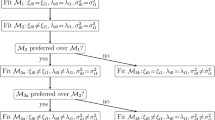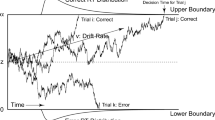Abstract
A wide variety of models have been developed for item response times. The models vary in both primary purpose and underlying assumptions. As noted by van der Linden (2016), several item response models assume response time and response accuracy are highly dependent processes. However, the nature of this assumed relationship varies substantially between models; that is, greater accuracy may be associated with either increased or decreased response time. In addition to these conflicting assumptions, examinees may differ in their relative response times across items. In the current study, the relationship of item log response times to item differences in difficulty and content was examined within subjects. Although on the item level, mean item log response time was positively correlated with difficulty, a broad distribution of these correlations was found within subjects, ranging from positive to negative. These results indicate that existing models may be differentially effective depending on examinees’ predominant strategy in item solving.
Access this chapter
Tax calculation will be finalised at checkout
Purchases are for personal use only
Similar content being viewed by others
References
Embretson, S. E. (1997). The factorial validity of a cognitively designed test: The Spatial Learning Ability Test. Educational and Psychological Measurement, 57, 99–107.
Meyer, J. P. (2010). A mixture Rasch model with item response time components. Applied Psychological Measurement, 34(7), 521–538.
Molenaar, D., & de Boeck, P. (2018). Response mixture modeling: Accounting for heterogeneity of item characteristics across response times. Psychometrika, 83, 279–297.
Roskam, E. E. (1997). Models for speed and time-limit tests. In W. J. van der Linden & R. K. Hambleton (Eds.), Handbook of modern item response theory (pp. 187–208). Springer.
Thissen, D. (1983). Timed testing: An approach using item response theory. In D. J. Weiss (Ed.), New horizons in testing: Latent trait test theory and computerized adaptive testing (pp. 179–203). Academic.
Van der Linden, W. (2016). Lognormal response-time model. In W. van der Linden (Ed.), Handbook of item response theory: Volume 1: Models (pp. 261–300). Taylor & Francis Inc.
Van der Linden, W.J., & Fox, J.-P. (2016) Joint hierarchical modeling of responses and response times. In Handbook of Modern Item Response Theory, W.J van der Linden (Ed.), Vol 1, Chapter 29, Chapman and Hall/CRC Press.
Wang, T., & Hanson, B. A. (2005). Development and calibration of an item response model that incorporates response time. Applied Psychological Measurement, 29, 323–339.
Wise, S. L., & DeMars, C. E. (2009). An application of item-response time: The effort-moderated IRT model. Journal of Educational Measurement, 43, 19–38.
Zopluoglu, C. (2020). A finite mixture item response theory model for continuous measurement outcomes. Educational and Psychological Measurement, 80(2), 346–364.
Author information
Authors and Affiliations
Corresponding author
Editor information
Editors and Affiliations
Rights and permissions
Copyright information
© 2021 The Author(s), under exclusive license to Springer Nature Switzerland AG
About this paper
Cite this paper
Embretson, S. (2021). Response Time Relationships Within Examinees: Implications for Item Response Time Models. In: Wiberg, M., Molenaar, D., González, J., Böckenholt, U., Kim, JS. (eds) Quantitative Psychology. IMPS 2020. Springer Proceedings in Mathematics & Statistics, vol 353. Springer, Cham. https://doi.org/10.1007/978-3-030-74772-5_5
Download citation
DOI: https://doi.org/10.1007/978-3-030-74772-5_5
Published:
Publisher Name: Springer, Cham
Print ISBN: 978-3-030-74771-8
Online ISBN: 978-3-030-74772-5
eBook Packages: Mathematics and StatisticsMathematics and Statistics (R0)




